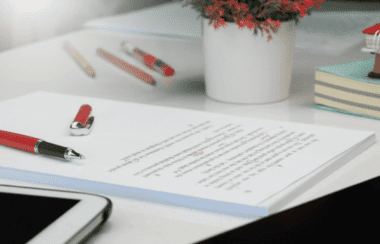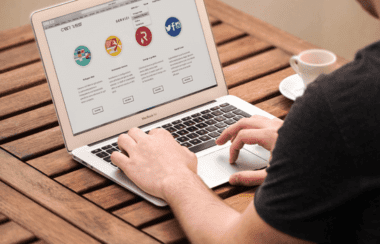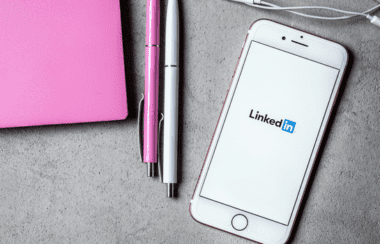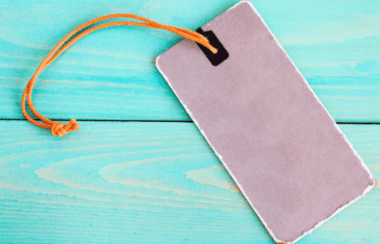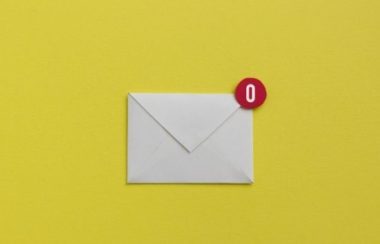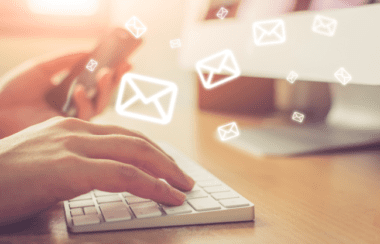Five Keys to Email Writing Success
By Jena Kroeker

Here we are again, talking about email writing success in 2022! Did you think email would be obsolete by now? Many of us did.
But emails are a bit like cars. Old movies and cartoons suggested we’d have our own personal flying machines by now. Instead, we’re still driving on roads and relying on airplanes to fly us further and faster.
And, like a reliable vehicle, email continues to faithfully transport information for us freelancers and virtual assistants. Specifically, it serves as a “steady foundation” and “preferred communication method for most people,” according to co-founder and instructor Craig Cannings in Freelance University’s Email Writing Success course. But that’s not all!
Email’s Popularity Takes Flight
Not only is email a steady foundation, it’s a rising star! Its popularity continues to grow, as evidenced by these stats from Statista:
“Despite the growth and prominence of mobile messengers and chat apps, e-mail is an integral part of daily online life. In 2020, the number of global e-mail users amounted to four billion and is set to grow to 4.6 billion users in 2025.”
Furthermore, Statista projects that the number of emails sent and received daily worldwide will increase to more than 376 billion emails in 2025, compared to 306 billion daily emails in 2020. Interestingly, 43 percent of email opens in December 2018 were on mobile devices, showing a definite trend toward mobile versus desktop or webmail opens.
Indeed, as Katrina Kirsch highlights in her article, “The Ultimate List of Email Marketing Stats for 2022,” most marketers are including mobile-friendly emails in their marketing strategy, with 77% observing increased email engagement during the past 12 months.
Does this mean email writing success is a sure thing, given these favorable trends? Not at all. We still need to hone our skills and mindfully craft our messages so they’ll have a safe flight and a gentle landing in the recipient’s inbox.
So, let’s look at five email “travel woes” and how you can impress your clients by avoiding them.
Five Keys to Email Writing Success (and Overcoming Travel Woes)
Imagine, if you will, an email airport. This is the place where Gmail, Microsoft Outlook, Apple Mail messages (and other favorite email clients) board their planes after you click “send.” There they are, all lined up with your thoughts, ideas, and attachments contained in their little suitcases.
Some are boarding scheduled flights, while others fly standby, waiting for the first available connection. Some show up spontaneously and quickly grab a ticket before hopping on the first flight out.
Unfortunately, like people, emails can suffer travel woes. Consequently, the time before boarding is crucial for ensuring a smooth flight and comfortable arrival. With each message, proper planning ensures email writing success. So, let’s unpack some common problems and the keys to overcoming them.
1. The Problem: Your message boarded the wrong plane.
Have you ever received an email and thought, “Why am I receiving this?” Sometimes you wonder why the sender chose you as the recipient, and sometimes you wonder why this message arrived by email at all. Depending on the topic, maybe it should have been a phone call or a video conference. Maybe it should have been an urgent text. Or maybe it should have been sent through your project management software.
When we’re discussing communication between freelancers or VAs and their clients or team members, the prevalence of mobile email apps is an important consideration. It’s easy to tap out a message and send it off without thinking too hard.
The Solution:
In his article, “8 Tips for Writing An Effective and Compelling Email,” David Fallarme recommends asking yourself the following questions to ensure empathy for the recipient and a proper vehicle for the message:
• “Why am I emailing this person?”
• “Is this the right person to contact, considering what I’m trying to achieve?”
• “Is my message clear and to the point?”
• “Would this be better discussed in a meeting?”
• “Does each line help or hurt my goal?”
For example, you and your client might prefer discussing projects via email. On the other hand, if you’re using project management software, you could direct any questions to the person who assigned the task through messaging features like the inbox in Asana. If you’re ending a relationship with a client, you might want to meet through video conferencing. But, in some difficult situations, you could choose email to maintain distance and a written record of the communication.
As Craig Cannings says in the course mentioned above, “If you’re not sure why you’re writing an email, DON’T send it!”
2. The Problem: Your message left at the wrong time.
It’s a common problem. An email arrives at an awkward time, making it difficult to respond promptly and thoughtfully. Sometimes it’s a time zone issue. The sender is hours ahead or behind the recipient. Sometimes it’s a circumstance issue. An email notification pops up just as a sink is overflowing or an emotional phone call is ending. And sometimes the email itself causes an emotional reaction, so answering right away would be the wrong time.
The Solution:
In most cases, an effective solution is to schedule your email or strategically choose a time to send it. However, in her article “The ultimate guide to writing great email content,” Ashley Hockney says,
“There’s no hard-and-fast rule for the best time to send an email. Some studies say 10 a.m. Others say 8 p.m. to midnight. The real answer is that it depends on your audience.”
Her advice applies to email lists or newsletters but is important for email writing success with any type of business communication. Always keep the recipient in mind. For instance, I like to schedule my emails or wait for an appropriate time, just in case the recipient has forgotten to mute their phone at night. The last thing I want is for my email to wake them up or interrupt their time with family. And I want them to know I have a healthy work-life balance too.
Furthermore, Ron Lieback warns against writing emails emotionally in his article, “How to Stop Writing Average Emails: 16 Quick Tips.” He advises,
“When emotions are flowing, especially in a negative or pressured manner, don’t write your emails. If things are urgent, like an urgent email from a client about a missed deadline, take a second and breathe. Go for a quick walk. Open a book. Do anything for some time but think about responding.
“Then respond when refreshed, or if you deal with someone who expects extremely urgent replies, respond that you’ll get right back ASAP. Then take that mental break.”
3. The Problem: Your fellow travelers can’t hear you.
As Craig Cannings says, “Knowing WHO you are writing to is critical to determine the voice, tone, style and content of your email message. Regardless of whether you are writing an email for a list of subscribers OR an individual, you almost always want to write to ONE person!”
Otherwise, your message will be lost in the roar of the airplane engines transporting your message. The communication with your fellow passengers (freelance clients or team members) will be meaningless and unintelligible if they receive it in a way that makes them confused or uncomfortable.
The Solution:
In a previous FreeU blog post, “Your Guide to Writing Effective Emails to Your Clients,” we recommend observing the recipient’s communication style so you can meet them where they’re at. Tailor the form, content, and vocabulary to suit their needs and preferences.
As an illustration, Karen Hertzberg shares some wise advice in her Grammarly article, “5 Proper Professional Email Format Tips to Help You Succeed.” She suggests mirroring what others do, adjusting your level of formality when needed. That way, your message will be clarified, not obscured, by the style. Specifically, she recommends,
“Even if you know the recipient well, zany salutations are inappropriate for business email. If your professional email happens to be forwarded or becomes part of a Reply All chain, people besides your intended recipient will see it. Keep it professional. Martin may be your buddy, but save the playful banter for when you’re off the clock.”
Most importantly, picture the recipient in your mind as you’re writing the email. Imagine them listening to what you’re saying, and speak directly to them as an individual.
4. The Problem: The plane is circling and needs to land.
This is another case where the style of an email can muffle your voice. “The plane is circling and needs to land” is what a family member gently tells me when I’m narrating a story and taking too long to get to the point. By adding extraneous details, my thoughts circle overhead, finding nowhere to land. The listener has no idea what the purpose of the story is.
In the same way, it’s easy to confuse email recipients with too many words and rambling explanations. They become overwhelmed, wading through your email content during their busy day to find the main purpose and call to action.
The Solution:
Email writing success involves giving just the right amount of information to inform and connect with people. The plane takes the shortest, most direct route possible. Your message should be simple, with short sentences and clear instructions about next steps. If an image would better communicate what you need to say, by all means, attach it.
In addition, the article above suggests using an outline to organize your thoughts if you’re composing a complex message. Another option is to ask the recipient if they’d like you to send an attached document with more detailed information. And, above all, proofread your email to fix typos and unnecessary wordiness.
5. The Problem: Your luggage is lost.
Some emails end up in the “lost luggage” section of the airport. They’re missing attachments, calls to action, next steps, and overall clarity. Recipients have no idea how they’re supposed to respond, and they’re not sure why they received the email in the first place. Sometimes they write you back to express their confusion. Other times, they leave your message sitting in their inbox, too busy to puzzle it out.
The Solution:
Just like a luggage tag should match the owner of a suitcase, a subject line should match the body copy of an email. Otherwise, your message could get lost in all the other little email suitcases your client or audience receive in their inbox. Recipients might feel tempted to ignore your message if they don’t understand its significance.
First, people need to feel motivated to open the email. Then, you need to pique their interest at the start of the email. Craig Cannings refers to this as creating a “unique connection point.” And, as we mentioned above, the email should include a clear call to action and next steps. Recipients should know exactly what the purpose is, what they need to do, and how to follow up.
In his article, “How to Write a Follow-Up Email After No Response,” Sujan Patel shares some valuable advice that can be applied to many types of emails:
“Avoid lazy follow-ups – ones where you’re simply ‘touching base’ or ‘catching up’ – that don’t add anything other than one more email in their inbox. Provide value at each interaction. Make it worth their while to open, click, and respond.”
By doing so, your message will arrive safely on the luggage carousel, directly into the hands of the person it’s intended for. And they’ll be eager to unpack it!
So, there you have it — five email travel woes you can overcome to achieve email writing success in your freelance or virtual assistant business! And now we’d love to hear your thoughts. How do you ensure that your emails will impress your clients and clearly communicate your thoughts and purpose? Please share any additional strategies in the comments below!










